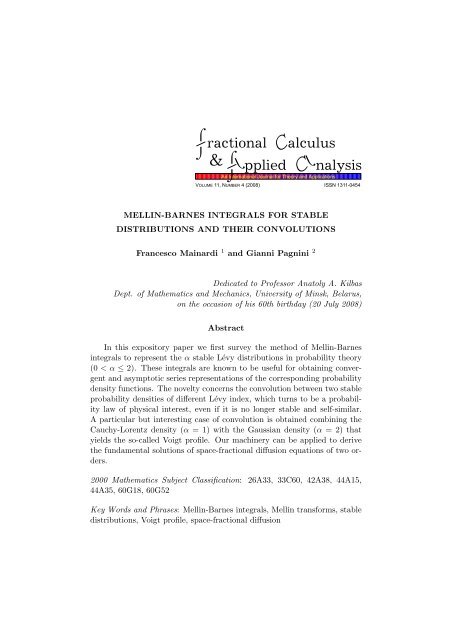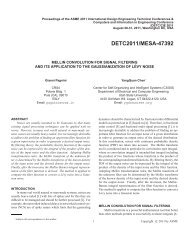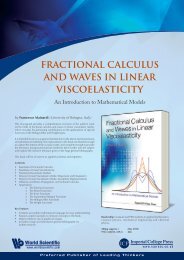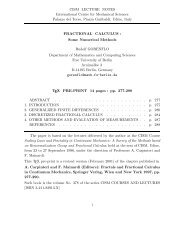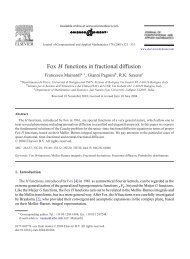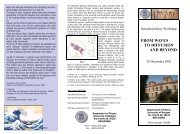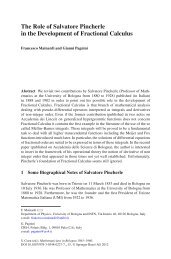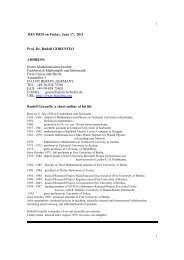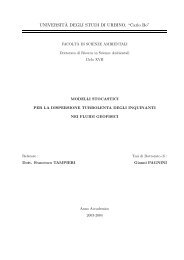MELLIN-BARNES INTEGRALS FOR STABLE DISTRIBUTIONS AND ...
MELLIN-BARNES INTEGRALS FOR STABLE DISTRIBUTIONS AND ...
MELLIN-BARNES INTEGRALS FOR STABLE DISTRIBUTIONS AND ...
Create successful ePaper yourself
Turn your PDF publications into a flip-book with our unique Google optimized e-Paper software.
<strong>MELLIN</strong>-<strong>BARNES</strong> <strong>INTEGRALS</strong> <strong>FOR</strong> <strong>STABLE</strong><br />
<strong>DISTRIBUTIONS</strong> <strong>AND</strong> THEIR CONVOLUTIONS<br />
Francesco Mainardi 1 and Gianni Pagnini 2<br />
Dedicated to Professor Anatoly A. Kilbas<br />
Dept. of Mathematics and Mechanics, University of Minsk, Belarus,<br />
on the occasion of his 60th birthday (20 July 2008)<br />
Abstract<br />
In this expository paper we first survey the method of Mellin-Barnes<br />
integrals to represent the α stable Lévy distributions in probability theory<br />
(0 < α ≤ 2). These integrals are known to be useful for obtaining convergent<br />
and asymptotic series representations of the corresponding probability<br />
density functions. The novelty concerns the convolution between two stable<br />
probability densities of different Lévy index, which turns to be a probability<br />
law of physical interest, even if it is no longer stable and self-similar.<br />
A particular but interesting case of convolution is obtained combining the<br />
Cauchy-Lorentz density (α = 1) with the Gaussian density (α = 2) that<br />
yields the so-called Voigt profile. Our machinery can be applied to derive<br />
the fundamental solutions of space-fractional diffusion equations of two orders.<br />
2000 Mathematics Subject Classification: 26A33, 33C60, 42A38, 44A15,<br />
44A35, 60G18, 60G52<br />
Key Words and Phrases: Mellin-Barnes integrals, Mellin transforms, stable<br />
distributions, Voigt profile, space-fractional diffusion
444 F. Mainardi, G. Pagnini<br />
Introduction<br />
Mellin-Barnes integrals are a family of integrals in the complex plane<br />
whose integrand is given by the ratio of products of Gamma functions. Despite<br />
of the name, the Mellin-Barnes integrals were initially introduced in<br />
1888 by the Italian mathematician S. Pincherle [27] in a couple of papers<br />
on the duality principle between linear differential equations and linear difference<br />
equations with rational coefficients, as discussed by the Authors in<br />
[20]. Only at the beginning of the XX century they were widely adopted by<br />
Mellin and Barnes. The Mellin-Barnes integrals are strongly related with<br />
the Mellin transform, in particular with its inverse transformation, in the<br />
framework of the so-called Melling setting. As shown in [22], [29], see also<br />
[10], [16], [32], [36], a powerful method to evaluate integrals can be obtained<br />
based on the Mellin setting. The Mellin-Barnes integrals are also essential<br />
tools for treating higher transcendental functions as generalized hypergeometric<br />
functions pFq and Meijer G- and Fox H-functions, see [17], [18],<br />
[23], [38]. Furthermore, they provide a useful representation to compute the<br />
asymptotic behaviour of functions, see [26], [40]. All the above machinery<br />
is also used in the theory of probability, see e.g. [21], [24], [34], [37], [39],<br />
[41], [42], and in theory of Fractional Calculus, see e.g. [4], [5], [6], [7],<br />
[8], [9], [15], [19], [28], [35]. We point out the forthcoming handbook on<br />
Mellin Transforms by Brychkov, Kilbas, Marichev and Prudnikov [3], that<br />
will surely become a table-text for most applied mathematicians.<br />
In this paper, after the essential notions and notations concerning the<br />
Mellin-Barnes integrals and the Mellin transform, we recall how the α stable<br />
distributions in probability theory (0 < α ≤ 2) can be represented<br />
by these tools. In the framework of symmetric distributions we illustrate<br />
our simple method to derive the known results. Then, we extend the<br />
method to derive the Mellin-Barnes representation for the probability densities<br />
obtained through a convolution of two stable densities of index α1, α2<br />
(0 < α1 < α2 ≤ 2). The case {α1 = 1 , α2 = 2} is of physical interest since<br />
it is related to the so-called Voigt profile function, well-known in molecular<br />
spectroscopy and atmospheric radiative transfer. We show how the convolution<br />
is of general interest since it enters in the treatment of space-fractional<br />
diffusion equations of double order. Finally, we point out that our results,<br />
being based on simple manipulations, can be understood by non-specialists<br />
of transform methods and special functions; however they could be derived<br />
through a more general analysis involving the functions of the Fox type.
<strong>MELLIN</strong>-<strong>BARNES</strong> <strong>INTEGRALS</strong> <strong>FOR</strong> <strong>STABLE</strong> <strong>DISTRIBUTIONS</strong> ...445<br />
1. The Mellin setting: basic formulas<br />
The Mellin-Barnes integrals are complex integrals which contain Gamma<br />
functions in their integrands as follows,<br />
MB±(z) = 1<br />
2πi<br />
γ+i∞<br />
γ−i∞<br />
Γ(a1 + A1s) · · · Γ(am + Ams)<br />
Γ(c1 + C1s) · · · Γ(cp + Cps)<br />
× Γ(b1 − B1s) · · · Γ(bn − Bns)<br />
Γ(d1 − D1s) · · · Γ(dq − Dqs) z±s ds .<br />
(1.1)<br />
It is assumed that γ is real, all the Aj, Bj, Cj, Dj are positive, and all the<br />
aj, bj, cj, j are complex. The path of integration is a straight line parallel to<br />
the imaginary axis with indentations, if necessary, to avoid the poles of the<br />
integrands. For more details see, e.g. [2], [11], [12], [26]. By using the residue<br />
theorem it is not difficult to formally expand these integrals in power series.<br />
The Melin-Barnes integrals are known to occur in the definitions of higher<br />
transcendental functions as generalized hypergeometric functions pFq and<br />
Meijer G- and Fox H-functions, see [17], [18], [23], [38], being related to<br />
their Mellin transforms.<br />
For convenience, let us here recall the essential formulas for this kind of<br />
integral transform, referring for details to specialized textbooks, e.g., [10],<br />
[16], [22], [3], [36]. Let<br />
M {f(x); s} = f ∗ (s) =<br />
+∞<br />
0<br />
f(x) x s−1 dx, γ1 < ℜ (s) < γ2, (1.2)<br />
be the Mellin transform of a sufficiently well-behaved function f(x) , and let<br />
M −1 {f ∗ (s); x} = f(x) = 1<br />
2πi<br />
γ+i∞<br />
f<br />
γ−i∞<br />
∗ (s) x −s ds (1.3)<br />
be the inverse Mellin transform, where x > 0 , γ = ℜ (s) , γ1 < γ < γ2 .<br />
It is straightforward to note that MB−(x) provide an essential tool for the<br />
inversion of Mellin transforms when these are expressed in terms products<br />
and ratios of Gamma functions.<br />
Denoting by M ↔ the juxtaposition of a function f(x) with its Mellin<br />
transform f ∗ (s) , the main rules are:<br />
f(ax) M ↔ a −s f ∗ (s) , a > 0 , (1.4)
446 F. Mainardi, G. Pagnini<br />
h1(x) =<br />
h2(x) =<br />
x a f(x) M ↔ f ∗ (s + a) , (1.5)<br />
f(x p ) M ↔ 1<br />
|p| f ∗ (s/p) , p = 0 , (1.6)<br />
∞<br />
1<br />
y<br />
0<br />
f(y) g(x/y) dy M ↔ h ∗ 1(s) = f ∗ (s) g ∗ (s) , (1.7)<br />
∞<br />
0<br />
f(xy) g(y) dy M ↔ h ∗ 2(s) = f ∗ (s) g ∗ (1 − s) . (1.8)<br />
The most simple example of Mellin transform is provided by the Legendre<br />
integral representation of the Gamma function<br />
Γ(s) =<br />
∞<br />
e<br />
0<br />
−x x s−1 dx , ℜ(s) > 0 , so e −x M<br />
↔ Γ(s) . (1.9)<br />
Henceforth, the Mellin-Barnes integral representation of exp(−z) turns to<br />
be<br />
e −z = 1<br />
<br />
Γ(s) z<br />
2πi L<br />
−s ∞ (−1)<br />
ds =<br />
n<br />
z<br />
n!<br />
n , (1.10)<br />
where L denotes a loop in the complex s plane which encircles the poles of<br />
Γ(s) (in the positive sense) with endpoints at infinity in ℜ(s) < 0 and with<br />
no restrictions on arg z.<br />
n=0<br />
2. Stable distributions and their Mellin setting<br />
The topic of stable distributions is a fascinating and fruitful area of<br />
research in probability theory; furthermore, nowadays, these distributions<br />
provide valuable models in physics, astronomy, finance, and communication<br />
theory. The general class of stable distributions was introduced and given<br />
this name by the French mathematician Paul Lévy in the early 1920’s.<br />
Stable distributions have three “exclusive” properties, which can be briefly<br />
summarized stating that they 1) are “invariant under addition”, 2) possess<br />
their own “domain of attraction”, and 3) admit a ”canonical characteristic<br />
function”.<br />
Referring to specialized textbooks for more details, see e.g. [1], [13],<br />
[31], [33], [39], [42], here we limit ourselves to consider the class of Lévy
<strong>MELLIN</strong>-<strong>BARNES</strong> <strong>INTEGRALS</strong> <strong>FOR</strong> <strong>STABLE</strong> <strong>DISTRIBUTIONS</strong> ...447<br />
strictly stable densities according to the Feller parameterization. Following<br />
Mainardi et al. [19], this class will be denoted by<br />
{L θ α(x)} , with 0 < α ≤ 2 , |θ| ≤ min {α, 2 − α} , x ∈ R , (2.1)<br />
where α denotes the index of stability (or Lévy index) and θ is a real parameter<br />
related to the asymmetry, improperly referred to as the skewness.<br />
Then, the canonical characteristic function, namely the Fourier transform<br />
of the density (2.1), is<br />
where<br />
F {L θ α(x); κ} = L θ α(κ) :=<br />
+∞<br />
−∞<br />
e iκx L θ <br />
α(x) dx = exp −ψ θ <br />
α(κ) , (2.2)<br />
ψ θ α(κ) := |κ| α e i(sign κ)θπ/2 = ψ θ α(−κ) = ψ −θ<br />
α (−κ) , κ ∈ R . (2.3)<br />
It is easy to note from their characteristic functions that the strictly stable<br />
densities are self-similar. Indeed, by setting with a > 0,<br />
L θ α(x; a) F <br />
↔ exp −a|κ| α e<br />
i(sign κ)θπ/2<br />
, (2.4)<br />
we have<br />
L θ α(x; a) = a −1/α L θ α<br />
<br />
x/a 1/α<br />
. (2.5)<br />
For θ = 0 we obtain symmetric densities of which noteworthy examples are<br />
provided by the Gaussian (or normal) law (with α = 2) and the Cauchy-<br />
Lorentz law (α = 1). The corresponding expressions are usually given as<br />
pG(x; σ) := 1<br />
√ 2π σ e −x2 /(2σ 2 ) := L 0 2(x; a = σ 2 /2) , x ∈ R , (2.6)<br />
where σ 2 denotes the variance, and<br />
pCL(x; χ) := 1<br />
π<br />
where χ denotes the semi-interquartile range.<br />
χ<br />
(x 2 + χ 2 ) := L0 1(x; a = χ) , x ∈ R , (2.7)<br />
Convergent and asymptotic series expansions for stable densities were<br />
introduced by Feller [13] in the 1950’s without be classified in the framework<br />
of a known class of special functions. A general representation of all<br />
stable distributions was only achieved in 1986 by Schneider [34], who, in his
448 F. Mainardi, G. Pagnini<br />
remarkable (but almost ignored) paper, recognized, through the Mellin setting,<br />
that these distributions can be characterized in terms of H-functions.<br />
We point out hat only in the earliest 1960’s this general class was been<br />
introduced into the realm of higher transcendental functions thanks to a<br />
pioneering article by Fox [14]. The result by Schneider can be summarized<br />
in his following expression of the Mellin transform for our L θ α(x):<br />
L θ ∗<br />
α (s) = ɛ<br />
Γ(s) Γ(ɛ − ɛs)<br />
1 α − θ<br />
, ɛ = , γ = , (2.8)<br />
Γ(γ − γs) Γ(1 − γ + γs) α 2α<br />
valid in the strip 0 < ℜ(s) < 1 . The inverse Mellin transform is thus given<br />
by<br />
L θ α(x) = 1<br />
c+i∞<br />
L<br />
2πi<br />
θ ∗ −s<br />
α (s) x ds , (2.9)<br />
c−i∞<br />
where the path of integration is the straight line from c − i∞ to c + i∞ with<br />
0 < c < 1. Then, the Mellin-Barnes representation turns out<br />
L θ α(x) = ɛ<br />
2πi<br />
c+i∞<br />
c−i∞<br />
Γ(s) Γ(ɛ − ɛs)<br />
Γ(γ − γs) Γ(1 − γ + γs) x−s ds . (2.10)<br />
Schneider obtained Eq (2.8) by transforming the Fourier transform (2.2)-<br />
(2.3) into a Mellin transform through a suitable deformation of the integration<br />
path in the complex plane, and then, starting from his Mellin-<br />
Barnes representation, he interpreted the stable densities in terms of Fox<br />
H-functions.<br />
In their 2001 paper on fundamental solutions of space-time fractional<br />
diffusion equations [19], Mainardi et al. obtained expressions of the Mellin-<br />
Barnes integrals for stable densities, see there Eq.(6.8)-(6.10), that are consistent<br />
with (2.10). We like to recall that stable densities evolving in time<br />
L θ α(x; t) are solutions for the space-fractional diffusion equation<br />
xD α θ<br />
u(x, t) = ∂<br />
∂t u(x, t) , x ∈ R , t ∈ R+ , (2.11)<br />
where the (real) field variable is subjected to the initial condition u(x, 0 + ) =<br />
δ(x). In (2.11) xDα θ denotes the so-called Riesz-Feller fractional derivative<br />
of order α (0 < α ≤ 2) and skewness θ (|θ| ≤ min {α, 2−α}). This fractional<br />
derivative is just defined as the pseudo-differential operator whose symbol<br />
is the logarithm of the characteristic function of the stable density Lθ α(x).<br />
This means, for any sufficiently well-behaved function f(x),<br />
F { xD α θ f(x); κ} = −ψθ α(κ) f(κ) , (2.12)
<strong>MELLIN</strong>-<strong>BARNES</strong> <strong>INTEGRALS</strong> <strong>FOR</strong> <strong>STABLE</strong> <strong>DISTRIBUTIONS</strong> ...449<br />
where ψθ α(κ) is given by (2.3). For α = 2 (θ = 0) this fractional derivative<br />
reduces to the standard derivative of order 2.<br />
In [19] the analysis was more extended than that by Schneider since it<br />
was also devoted to other types of probability density functions as those<br />
generated by diffusion equations of fractional order in time. Furthermore,<br />
their method for deriving the Mellin-Barnes integrals was different from<br />
that of Schneider, even if equivalent, being based on the reduction of the<br />
relevant Fourier transform into a product of two Mellin transforms.<br />
Here we like to offer a simpler and more direct method than those<br />
adopted in [19], [34], but, for sake of simplicity, limiting ourselves to the<br />
Mellin-Barnes representation for the symmetric stable densities. In this<br />
case we start from the inversion formula of Fourier transform<br />
L 0 α(x) = 1<br />
2π<br />
+∞<br />
e<br />
−∞<br />
−ikx e −|κ|α<br />
dκ . (2.13)<br />
The Mellin-Barnes integral representation of (2.13) can be obtained starting<br />
from the Mellin-Barnes representation of the exponential function e−iκx ,<br />
(κx = 0), see (1.10):<br />
e −iκx = 1<br />
2πi<br />
<br />
L<br />
Γ(s) (iκx) −s ds , (2.14)<br />
where L is a loop in the complex s plane that encircles the poles of Γ(s)<br />
in the positive sense, with end-points at infinity at ℜ(s) < 0 and with no<br />
restriction on arg (iκx).<br />
Inserting (2.14) into (2.13) gives<br />
L 0 α(x) = 1<br />
2π<br />
= 1<br />
2π<br />
+∞ <br />
1<br />
<br />
−∞<br />
1<br />
2πi<br />
2πi<br />
Γ(s)<br />
L<br />
Γ(s) (iκx) −s <br />
ds e −|κ|α<br />
dκ<br />
e −|κ|α<br />
(iκ) −s <br />
dκ x −s ds ,<br />
L<br />
+∞<br />
−∞<br />
(2.15)<br />
with the condition ℜ(s) < 1 for convergence of term in brackets in the second<br />
line. Using the Legendre integral representation of the Gamma function<br />
(1.10) valid for ℜ(z) > 0 , the term in brackets can be re-written as follows<br />
+∞<br />
e −|κ|α<br />
(iκ) −s dκ = i −s + (−i) −s 1<br />
<br />
1 − s<br />
−∞<br />
= 2 sin<br />
= 2π<br />
α<br />
α Γ<br />
α<br />
<br />
π<br />
<br />
1<br />
(1 + s)<br />
2 α Γ<br />
<br />
1 − s<br />
α<br />
Γ <br />
1−s<br />
α<br />
Γ <br />
1+s<br />
1+s ,<br />
2 Γ 1 − 2<br />
(2.16)
450 F. Mainardi, G. Pagnini<br />
which gives<br />
with 0 < ℜ(s) < 1.<br />
L 0 α(x) = 1<br />
<br />
1<br />
α 2πi<br />
L<br />
Γ(s)Γ <br />
1−s<br />
α<br />
Γ <br />
1+s<br />
1+s x<br />
2 Γ 1 − 2<br />
−s ds , (2.17)<br />
In view of the similarity property (2.5), the Mellin-Barnes integral representation<br />
for L0 α(x; a) is easily derived from (2.17) as<br />
L 0 α(x; a) = 1<br />
α a1/α <br />
1 Γ(s) Γ<br />
2πi L<br />
<br />
1−s<br />
α<br />
Γ <br />
x<br />
<br />
1+s<br />
1+s<br />
2 Γ 1 − a 2<br />
1/α<br />
−s ds . (2.18)<br />
3. Mellin setting for the generalized Voigt profile<br />
Let us now consider the convolution of two symmetric stable densities<br />
of index α1, α2 (0 < α1 < α2 ≤ 2) with scale factors a1, a2, respectively:<br />
V (x; (α1, a1), (α2, a2)) =<br />
+∞<br />
−∞<br />
L 0 α1 (x − ξ; a1) L 0 α2 (ξ; a2) dξ . (3.1)<br />
This function provides the probability density function for the sum of two<br />
independent random variables obeying stable laws with different Lévy index.<br />
Being α1 = α2 the density (3.1) is no longer stable either self-similar.<br />
Furthermore, it can be interpreted as the fundamental solution of the spacefractional<br />
diffusion equation of distributed order<br />
[c1 xD α1<br />
0 + c2 xD α2<br />
0<br />
] u(x, t) = ∂<br />
∂t u(x, t) , x ∈ R , t ∈ R+ , (3.2)<br />
with a1 = c1t and a2 = c2t. We refer to our paper [24] for more details and<br />
instructive plots about this probability distribution and also on bibliography<br />
on the particular case (of physical relevance) {α1 = 1 , α2 = 2} known as<br />
Voigt profile. For the Voigt profile, see also the pre-print [25].<br />
Here we limit ourselves to derive the Mellin-Barnes integral representation<br />
for the convoluted density (3.1), that we refer to as the generalized<br />
Voigt profile, by extending the method illustrated in the previous section<br />
for the single density, see (2.18). We start from the characteristic function<br />
(dropping in the L.H.S the dependence on Lévy indices and scale factors)<br />
V(κ) = e −a1 |κ| α 1−a2 |κ| α 2 , (3.3)
<strong>MELLIN</strong>-<strong>BARNES</strong> <strong>INTEGRALS</strong> <strong>FOR</strong> <strong>STABLE</strong> <strong>DISTRIBUTIONS</strong> ...451<br />
from which<br />
V(x) = 1<br />
2π<br />
with<br />
+∞<br />
−∞<br />
e −iκx e −a1 |κ| α 1−a2 |κ| α 2 dκ = 1<br />
2π {Y+(x) + Y−(x)} , (3.4)<br />
Y±(x) =<br />
+∞<br />
e −(a1 κ α 1±iκx) e −a2κ α 2 dκ . (3.5)<br />
0<br />
Following our method of the previous section we use the Mellin-Barnes representation<br />
for the exponential functions e ±iκx and e−a1 kα1 , so the functions<br />
Y±(x) read<br />
Y±(x) =<br />
+∞<br />
e<br />
0<br />
−a2κα2 1<br />
2πi<br />
<br />
L1<br />
<br />
1<br />
<br />
2πi L0<br />
Γ(s0) Γ(s1)(±iκx) −s0 (a1 κ α1 ) −s1 ds0 ds1<br />
<br />
dκ .<br />
(3.6)<br />
Because of the absolute convergence of this integral, we can interchange<br />
the order of integration and applying the definition of Gamma function we<br />
obtain<br />
Y±(x) = 1<br />
α2<br />
1<br />
2πi<br />
<br />
L0<br />
<br />
<br />
1<br />
1 − s0 − α1s1<br />
Γ(s0) Γ(s1)Γ<br />
2πi L1<br />
α2<br />
× (±ix) −s0 a −(1−s0−α1s1)/α2<br />
2<br />
a −s1<br />
1<br />
ds0 ds1 .<br />
(3.7)<br />
Now, considering that ±ix = xe ±iπ/2 , the generalized Voigt function assumes<br />
the Mellin-Barnes integral representation<br />
V(x) = 1<br />
<br />
<br />
1 1<br />
1 − s0 − α1s1<br />
Γ(s0) Γ(s1) Γ<br />
πα2 2πi 2πi<br />
α2<br />
(3.8)<br />
L0<br />
L1<br />
× cos(s0 π/2) x −s0 a −(1−s0−α1s1)/α2<br />
2<br />
a −s1<br />
1<br />
ds0 ds1 .<br />
The Mellin-Barnes integral representation of the special case of the Voigt<br />
profile ({α1 = 1 , α2 = 2}) turns out to be expressed by a single integral<br />
in the complex plane. In this case the functions Y±(x) have the following<br />
Mellin-Barnes integral representations valid for 0 < ℜ(s) < 1<br />
+∞ <br />
−a2κ2 1<br />
Y±(x) = e Γ(s) [(a1 ± ix)κ] −s <br />
ds dκ<br />
0<br />
= 1<br />
2πi<br />
<br />
L<br />
Γ(s)<br />
= 1<br />
2a1/2 1<br />
2πi<br />
<br />
L<br />
2πi<br />
∞<br />
L<br />
−a2κ2 e κ<br />
0<br />
−s dκ (a1 ± ix) −s ds ,<br />
<br />
1 s<br />
Γ(s)Γ −<br />
2 2<br />
<br />
(a1 ± ix)<br />
a 1/2<br />
−s ds .<br />
2<br />
<br />
(3.9)
452 F. Mainardi, G. Pagnini<br />
then the Voigt profile (denoted now by V (x)) turns out<br />
V (x) =<br />
1<br />
4πa 1/2<br />
2<br />
<br />
1<br />
2πi<br />
<br />
+ 1<br />
<br />
2πi<br />
L<br />
L<br />
<br />
1 s<br />
Γ(s) Γ −<br />
2 2<br />
<br />
(a1 + ix)<br />
a 1/2<br />
2<br />
<br />
1 s<br />
Γ(s)Γ −<br />
2 2<br />
<br />
(a1 − ix)<br />
a 1/2<br />
2<br />
−s<br />
−s<br />
ds<br />
<br />
ds<br />
.<br />
(3.10)<br />
Finally, after lengthy manipulations involving H- and G- functions and detailed<br />
in [25], the Mellin-Barnes integral representation of the Voigt function<br />
(3.10) yields the following expression in terms of complementary error functions<br />
of complex conjugate arguments<br />
1<br />
V (x) =<br />
4 √ π a2<br />
<br />
e Z2 /4 Z<br />
erfc(Z/2) + e 2 <br />
/4<br />
erfc(Z/2) , (3.11)<br />
where, for convenience, we have set Z = (a1 + ix)/a 1/2<br />
2 .<br />
Conclusions<br />
In this paper we have revisited the Mellin-Barnes integral representation<br />
for the stable distributions in probability theory, and we have illustrated a<br />
simple method to derive it. Such method has been extended to derive the<br />
Mellin-Barnes integrals for the convolution of two stable densities of different<br />
Lévy index, corresponding to a probability density that generalizes<br />
the Voigt profile function, well-known in molecular spectroscopy and atmospheric<br />
radiative transfer. The generalized Voigt density, when is evolving in<br />
time, can be interpreted as the fundamental solution of a fractional diffusion<br />
equation with two space derivatives of non-integer order.<br />
Finally, our analysis can be considered as a first step of a machinery<br />
related to Mellin-Barnes integrals, the so-called Mellin setting, that can<br />
be pursued by researchers in analytical and numerical theory of special<br />
functions and fractional calculus.
<strong>MELLIN</strong>-<strong>BARNES</strong> <strong>INTEGRALS</strong> <strong>FOR</strong> <strong>STABLE</strong> <strong>DISTRIBUTIONS</strong> ...453<br />
References<br />
[1] O.E. Barndorff-Nielsen, T. Mikosch and S.I. Resnick (Editors), Lévy<br />
Processes: Theory and Applications. Birkhäuser, Boston, MA (2001).<br />
[2] B.L.J. Braaksma, Asymptotic expansions and analytical continuations<br />
for a class of Barnes-integrals. Compositio Mathematica 15 (1962), 239-<br />
341.<br />
[3] Yu.A. Brychkov, A.A. Kilbas, O.I. Marichev and A.P. Prudnikov,<br />
Handbook on Mellin Transforms. Cambridge Scientific Publishers,<br />
Cambridge (2009), To appear.<br />
[4] P. Butzer and S. Jansche, A direct approach to Mellin transform. J.<br />
Fourier Anal. Appl. 3 (1997), 325-376.<br />
[5] P. Butzer and S. Jansche, Mellin transform theory and the role of its<br />
differential and integral operators. In: P. Rusev, I. Dimovski and V.<br />
Kiryakova (Editors), Transform Methods & Special Functions, Varna<br />
’96. Proc. Second Int. Conference, Varna (Bulgaria), 23-30 Aug 1996.<br />
Bulgarian Academy of Sciences (ISBN 954-8986-05-1), Sofia (1998),<br />
63-83.<br />
[6] P. Butzer, A.A. Kilbas and J.J. Trujillo, Fractional calculus in the<br />
Mellin setting and Hadamard-type fractional integrals. Journal of<br />
Mathematical Analysis and Applications 269 (2002), 1-27.<br />
[7] P. Butzer, A.A. Kilbas and J.J. Trujillo, Compositions of Hadamardtype<br />
fractional integration operators and the semigroup property. Journal<br />
of Mathematical Analysis and Applications 269 (2002), 387-400.<br />
[8] P. Butzer, A.A. Kilbas and J.J. Trujillo, Mellin transform analysis and<br />
integration by parts for Hadamard-type fractional integrals. Journal of<br />
Mathematical Analysis and Applications 270 (2002), 1-15.<br />
[9] P. Butzer and U. Westphal, Introduction to fractional calculus. In: H.<br />
Hilfer (Editor), Fractional Calculus, Applications in Physics. World<br />
Scientific, Singapore (2000), 1-85.<br />
[10] B. Davies, Integral Transforms and their Applications, 2-nd edn.<br />
Springer-Verlag, New York (1985).
454 F. Mainardi, G. Pagnini<br />
[11] A.L. Dixon and W.L. Ferrar, A class of discontinuous integrals. Quart.<br />
J. Mathematics, Oxford Series 7 (1936), 81-96.<br />
[12] A. Erdélyi, W. Magnus, F. Oberhettinger, and F.G. Tricomi, Higher<br />
Transcendental Functions (Bateman Project), Vol 1. McGraw-Hill,<br />
New York (1953) [See § 1.19 : Mellin-Barnes integrals].<br />
[13] W. Feller, An Introduction to Probability Theory and its Applications,<br />
Vol. 2, 2-nd edn. Wiley, New York (1971). [1-st edn. (1966)]<br />
[14] C. Fox, The G and H functions as symmetrical Fourier kernels. Trans.<br />
Amer. Math. Soc. 98 (1961), 395-429.<br />
[15] R. Gorenflo, A. Iskenderov and Yu. Luchko, Mapping between solutions<br />
of fractional diffusion-wave equations. Fractional Calculus and<br />
Applied Analysis 3 (2000), 75-86.<br />
[16] P. Henrici, Applied and Computational Complex Analysis, Vol. 2. Wiley,<br />
New York (1991).<br />
[17] A.A. Kilbas and M. Saigo, H-transforms. Theory and Applications.<br />
CRC Press, New York (2004).<br />
[18] V. Kiryakova, Generalized Fractional Calculus and Applications. Longman,<br />
Harlow (1994) [Pitman Research Notes in Mathematics, Vol. 30]<br />
& J. Wiley, New York (1994).<br />
[19] F. Mainardi, Yu. Luchko and G. Pagnini, The fundamental<br />
solution of the space-time fractional diffusion equation. Fractional<br />
Calculus and Applied Analysis 4 (2001), 153-192 [E-print<br />
http://arxiv.org/abs/cond-mat/0702419].<br />
[20] F. Mainardi and G. Pagnini, Salvatore Pincherle: The pioneer<br />
of the Mellin-Barnes integrals. Journal of Computational<br />
and Applied Mathematics 153 (2003), 331-342 [E-print<br />
http://arxiv.org/abs/math/0702520].<br />
[21] F. Mainardi, G. Pagnini and R. Gorenflo, Mellin transform and<br />
subordination laws in fractional diffusion processes. Fractional Calculus<br />
and Applied Analysis 6, No 4 (2003), 441-459 [E-print<br />
http://arxiv.org/abs/math/0702133].
<strong>MELLIN</strong>-<strong>BARNES</strong> <strong>INTEGRALS</strong> <strong>FOR</strong> <strong>STABLE</strong> <strong>DISTRIBUTIONS</strong> ...455<br />
[22] O.I. Marichev, Handbook of Integral Transforms of Higher Transcendental<br />
Functions, Theory and Algorithmic Tables. Chichester, Ellis<br />
Horwood (1983).<br />
[23] A.M. Mathai, R.K. Saxena, The H-function with Applications in<br />
Statistics and Other Disciplines. Wiley Eastern Ltd, New Delhi (1978).<br />
[24] G. Pagnini and F. Mainardi, Evolution equations of the probabilistic<br />
generalization of the Voigt profile function. To appear in:<br />
Journal of Computational and Applied Mathematics (2008) [E-print<br />
http://arxiv.org/abs/0711.4246, 9 pages (Mathematical Physics)].<br />
[25] G. Pagnini and R.K. Saxena, A note on the Voigt profile function.<br />
E-print http://arxiv.org/abs/0805.2274, 13 pages (Mathematical<br />
Physics).<br />
[26] R.B. Paris and D. Kaminski, Asymptotic and Mellin-Barnes Integrals.<br />
Cambridge University Press, Cambridge (2001) [Encyclopedia<br />
of Mathematics and Its Applications, No. 85].<br />
[27] S. Pincherle, Sulle funzioni ipergeometriche generalizzate. Atti R. Accad.<br />
Lincei, Rend. Cl. Sci. Fis. Mat. Natur. (Ser 4) 4 (1888), 694-700,<br />
792-799 [Reprinted in Salvatore Pincherle: Opere Scelte, Vol. 1, UMI<br />
(Unione Matematica Italiana) Cremonese, Roma (1954), 223-230, 231-<br />
239)].<br />
[28] I. Podlubny, Fractional Differential Equations. Academic Press, San<br />
Diego (1999).<br />
[29] A.P. Prudnikov, Yu.A. Brychkov, and O.I. Marichev, Evaluation of<br />
integrals and the Mellin transform. J. Sov. Math. 54, No 6 (1991),<br />
1239-1341 [Translated from Itogi Nauki i Tekhniki, Ser. Mat. Anal.,<br />
Vol. 27 (1989), 3-146].<br />
[30] A.P. Prudnikov, Y.A. Brychkov and O.I. Marichev, Integrals and Series,<br />
Vol. 3. Gordon and Breach Science Publ., New York (1990).<br />
[31] G. Samorodnitsky and M.S. Taqqu, Stable non-Gaussian Random Processes.<br />
Chapman & Hall, New York (1994).<br />
[32] R.J. Sasiela and J.D. Shelton, Mellin transform methods applied to<br />
integral evaluation: Taylor series and asymptotic approximations. J.<br />
Mathematical Physics 34, No 6 (1993), 2572-2617.
456 F. Mainardi, G. Pagnini<br />
[33] K. Sato, Lévy Processes and Infinitely Divisible Distributions. Cambridge<br />
University Press, Cambridge (1999).<br />
[34] W.R. Schneider, Stable distributions: Fox function representation and<br />
generalization. In: S. Albeverio, G. Casati and D. Merlini (Editors),<br />
Stochastic Processes in Classical and Quantum Systems. Springer-<br />
Verlag, Berlin-Heidelberg (1986), 497-511 [Lecture Notes in Physics,<br />
Vol. 262].<br />
[35] W.R. Schneider and W. Wyss, Fractional diffusion and wave equations.<br />
J. Math. Phys. 30 (1989), 134-144.<br />
[36] I.N. Sneddon, The Use of Integral Transforms. McGraw-Hill, New York<br />
(1972).<br />
[37] M.D. Springer, The Algebra of Random Variables. Wiley, New York<br />
(1979).<br />
[38] H.M. Srivastava, K.C. Gupta and S.P. Goyal, The H-Functions of One<br />
and Two Variables with Applications. South Asian Publishers, New<br />
Delhi and Madras (1982).<br />
[39] V.V. Uchaikin and V.M. Zolotarev, Chance and Stability. Stable Distributions<br />
and their Applications. VSP, Utrecht (1999).<br />
[40] R. Wong, Asymptotic Approximations of Integrals. Academic Press,<br />
Boston, MA (1989).<br />
[41] V.M. Zolotarev, Mellin-Stieltjes transform in probability theory.<br />
Theor. Prob. Appl. 2 (1957), 433-460.<br />
[42] V.M. Zolotarev, One-dimensional Stable Distributions. Amer. Math.<br />
Soc., Providence, R.I. (1986) [Translation from the Russian edition<br />
(1982)].<br />
1 Department of Physics, University of Bologna and INFN,<br />
Via Irnerio 46, I-40126 Bologna – ITALY<br />
e-mail: mainardi@bo.infn.it<br />
Received: July 24, 2008<br />
2 ENEA, Centre “Ezio Clementel”<br />
via Martiri di Monte Sole 4, I-40129 Bologna – ITALY<br />
e-mail: gianni.pagnini@bologna.enea.it


